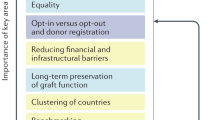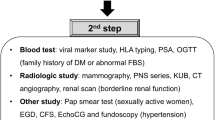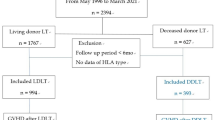Abstract
The success of liver transplantation worldwide has brought increased demand for the liver graft. Western and Asian countries have coped differently with the problems of the shortages in organ donation. In the West, efforts have focused on promoting deceased donor organ donation, whereas in Asia the focus has been on living donor liver transplantation (LDLT), as this procedure is more acceptable in most Asian cultures. LDLT, which was initially devised for paediatric liver transplant patients, has evolved from using a left lobe graft to a right lobe graft for an adult recipient. To widen the donor pool, dual grafts for a single recipient have been used in LDLT, and donors with hepatitis B core antibody positivity have been accepted, as well as ABO incompatible donors and recipients. The great advances in the field of LDLT have been dictated by the needs and the norms of Asian society. In this Perspectives article, we outline the reasons why LDLT flourishes in Asia.
This is a preview of subscription content, access via your institution
Access options
Subscribe to this journal
Receive 12 print issues and online access
$209.00 per year
only $17.42 per issue
Buy this article
- Purchase on Springer Link
- Instant access to full article PDF
Prices may be subject to local taxes which are calculated during checkout
Similar content being viewed by others
References
Starzl, T. E. et al. Orthotopic homotransplantation of the human liver. Ann. Surg. 168, 392–415 (1968).
Bismuth, H. & Houssin, D. Reduced-sized orthotopic liver graft in hepatic transplantation in children. Surgery 45, 519–524 (1988).
Pichlmayr, R., Ringe, B. & Gubernatis, G. Transplantation of donor liver to 2 recipients (Splitting transplantation)—a new method in further development of segmental liver transplantation. Langenbecks Archiv. Chir. 373, 127–130 (1989).
Sanz, A., Boni, R. C., Ghirardini, A., Costa, A. N. & Manyalich, M. IRODaT 2006. International donation and transplant activity. Organs, Tissues & Cells 2, 77–80 (2007).
Global Observatory on Donation and Transplantation. Liver transplant activity (total). Global Observatory on Donation and Transplantation [online], (2013).
De Villa, V. H., Lo, C. M. & Chen, C. L. Ethics and rationale of living-donor liver transplantation in Asia. Transplantation 75, S2–S5 (2003).
Van Gelder, F., Manyalich, M., Costa, A. N. & Paez, G. 2009 International donation and transplantation activity. Organs, Tissues & Cells 2, 77 (2010).
Oliver, M., Woywodt, A., Ahmed, A. & Saif, I. Organ donation, transplantation and religion. Nephrol. Dial. Transplant. 26, 437–444 (2011).
Nagral, S. Organ transplantation: ethical issues and the Indian scenario. Issues Med. Ethics 9, 41–43 (2001).
Concejero, A. M. & Chen, C. L. Ethical perspectives in living donor organ transplantation in Asia. Liver Transpl. 15, 1658–1661 (2009).
Ernst, E. & Sherman, K. J. Is acupuncture a risk factor for hepatitis? Systemic review of epidemiological studies. J. Gastroenterol. Hepatol. 11, 1231–1236 (2003).
Lu, S. N. et al. Secular trends and geographic variations of hepatitis B virus and hepatitis C virus-associated hepatocellular carcinoma in Taiwan. Int. J. Cancer 119, 1946–1952 (2006).
Shin, H. R. et al. Hepatitis B and C virus prevalence in a rural area of South Korea: the role of acupuncture. Br. J. Cancer 87, 314–318 (2002).
Sun, C. A. et al. Transmission of hepatitis C virus in Taiwan: prevalence and risk factors based on nationwide survey. J. Med. Virol. 3, 290–296 (1999).
World Health Organization. Prevention and control of viral hepatitis infection: framework for global action. World Health Organization [online], (2013).
Hwang, E. W. & Cheung, R. Global epidemiology of Hepatitis B virus (HBV) infection. N. Am. J. Med. Sci. 4, 7–13 (2011).
Hanafiah, K. M., Groeger, J., Flaxman, A. & Wiersma, S. T. Global epidemiology of hepatitis C virus infection: new estimates of age-specific antibody to HCV seroprevalence. Hepatology 57, 1333–1342 (2013).
Han, K. W. et al. Asian consensus workshop report: expert consensus guideline for the management of intermediate and advanced hepatocellular carcinoma in Asia. Oncology 81 (Suppl. 1), 158–164 (2011).
GLOBOCAN 2008. Liver cancer incidence and mortality worldwide in 2008. GLOBOCAN 2008 [online], (2013).
Sugawara, Y., Tamura, S. & Makuuchi, M. Living donor liver transplantation for hepatocellular carcinoma: the Tokyo series. Dig. Dis. 25, 310–312 (2007).
Takada, Y. & Uemoto, S. Liver transplantation for hepatocellular carcinoma: the Kyoto experience. J. Hepatobiliary Pancreat. Sci. 17, 527–532 (2010).
Lee, S. et al. Liver transplantation for hepatocellular carcinoma: Korean experience. J. Hepatobiliary Pancreat. Sci. 17, 539–547 (2010).
Zheng, S. S. et al. Liver transplantation for hepatocellular carcinoma: Hangzhou experiences. Transplantation 85, 1726–1732 (2008).
Chen, C. L., Wang, K. L. & Lee, M. Liver transplantation for Wilson's disease: report of the first successful liver transplant in Taiwan. Jpn. J. Transplant. 22, 178–184 (1987).
Ng, K. K. & Lo, C. M. Liver transplantation in Asia: past, present and future. Ann. Acad. Med. Singapore 38, 322–331 (2009).
Kimura, R. Organ transplantation and brain-death in Japan. Cultural, legal and bioethical background. Ann. Transplant. 3, 55–58 (1998).
Chen, C. L. et al. Initiation of split liver transplantation in Taiwan. Transplant. Proc. 30, 3249 (1998).
Chen, C. L. & de Villa, V. H. Split liver transplantation. Asian J. Surg. 4, 285–290 (2002).
Strong, R. W. et al. Successful liver transplantation from a living donor to her son. N. Engl. J. Med. 322, 1505–1507 (1990).
Nagasue, N. et al. Segmental (partial) liver transplantation from a living donor. Transplant. Proc. 24, 1958–1959 (1992).
Lee, S. G. Asian contributions to living donor liver transplantation. J. Gastroenterol. Hepatol. 21, 572–574 (2006).
Hashikura, Y. et al. Successful living-related partial liver transplantation to an adult patient. Lancet 343, 1233–1234 (1994).
Lo, C. M. et al. Extending the limit of the size of adult recipient in living donor liver transplantation using extended right lobe graft. Transplantation 63, 1524–1528 (1997).
Lee, S. G. et al. An adult-to adult living donor liver transplant using dual left lobe grafts. Surgery 129, 647–650 (2001).
Chen, C. L., Concejero, A. M. & Cheng, Y. F. More than a quarter of century of liver transplantation in Kaohsiung Chang Gung Memorial Hospital. Clin. Transpl. 2011, 213–221 (2011).
Shimada, M. et al. Living donor liver transplantation: present status and future perspective. J. Med. Invest. 52, 22–32 (2005).
Kaido, T. et al. Lower limit of the graft-to-recipient weight ratio can be safely reduced to 0.6% in adult-to-adult living donor liver transplantation in combination with portal pressure control. Transplant. Proc. 43, 2391–2393 (2011).
Lee, S. G. Living donor liver transplantation in adults. Br. Med. Bull. 94, 33–48 (2010).
Dutkowski, P., de Rougemont, O., Mullhaupt, B. & Clavien, P. A. Current and future trends in liver transplantation in Europe. Gastroenterology 138, 802–809 (2010).
Pomfret, E. A. et al. Solving the organ shortage crisis. Am. J. Transpl. 8, 745–752 (2008).
Lee, S. D. & Kim, J. H. Changes in the organ procurement system in South Korea: effects on brain-dead donor numbers. Transplant. Proc. 41, 3551–3555 (2009).
Min, S. I. et al. Trends in deceased organ donation and utilization in Korea: 2000–2009. J. Korean Med. Sci. 25, 1122–1127 (2010).
Huang, J. Ethical and legislative perspectives on liver transplantation in the People's Republic of China. Liver Transpl. 13, 193–196 (2007).
Wang, H. New era for organ donation and transplantation in China. Interview by Fiona Fleck. Bull. World Health Organ. 90, 802–803 (2012).
Huang, J. et al. A pilot programme of organ donation after cardiac death in China. Lancet 379, 862–865 (2012).
Huang, J. et al. The national program for deceased organ donation in China. Transplantation 96, 5–9 (2013).
Delmanico, F. L. The development of the declaration of Istanbul on organ trafficking and transplant tourism. Nephrol. Dial. Transplant. 23, 3381–3382 (2008).
Ou, H. Y. et al. Early modulation of portal graft inflow in adult living donor liver transplant recipients with high portal inflow detected by intraoperative color Doppler ultrasound. Transplant. Proc. 42, 876–878 (2010).
Lin, T. S. et al. Routine microsurgical biliary reconstruction decreases early anastomotic complications in living donor liver transplantation. Liver Transpl. 15, 1766–1775 (2009).
Lin, T. S. et al. Early and long-term results of routine microsurgical biliary reconstruction in living donor liver transplantation. Liver Transpl. 19, 207–214 (2013).
Avelino-Silva, V. I. et al. Liver transplant from anti-HBc-positive, HBsAg-negative donor into HBsAg-negative recipient: is it safe? A systematic review of literature. Clin. Transplant. 24, 735–746 (2010).
Lin, C. C. et al. Active immunization to prevent de novo hepatitis B virus infection in pediatric live donor liver recipients. Am. J. Transplant. 7, 195–200 (2007).
Warner, P. R. & Nester, T. A. ABO-incompatible solid-organ transplantation. Am. J. Clin. Pathol. 125 (Suppl 1), S87–S94 (2006).
Ikegami, T. et al. Rituximab, IVIG, and plasma exchange without graft local infusion treatment: a new protocol in ABO incompatible living donor liver transplantation. Transplantation 88, 303–307 (2009).
Tanabe, M. et al. Current progress in ABO-incompatible liver transplantation. Eur. J. Clin. Invest. 40, 943–949 (2010).
Raut, V. et al. Splenectomy does not offer immunological benefits in ABO-incompatible liver transplantation with a preoperative rituximab. Transplantation 93, 99–105 (2012).
Hwang, S. et al. Exchange living donor liver transplantation to overcome ABO incompatibility in adult patients. Liver Transpl. 16, 482–490 (2010).
Wu, J. et al. Recipient outcomes after ABO-incompatible liver transplantation: a systematic review and meta-analysis. PLoS ONE 6, e16521 (2011).
Segev, D. L. & Montgomery, R. A. The application of paired donation to living donor liver transplantation. Liver Transpl. 16, 423–425 (2010).
Jingwei, A. H., Yu-Hung, A. L. & Ching, L. Living organ transplantation policy transition in Asia: towards adaptive policy changes. Global Health Governance [online], (2013).
European Liver Transplant Registry. LRLT analysis – booklet. European liver transplant registry [online], (2013).
Author information
Authors and Affiliations
Contributions
All the authors contributed to all aspects of this manuscript.
Corresponding author
Ethics declarations
Competing interests
The authors declare no competing financial interests.
Rights and permissions
About this article
Cite this article
Chen, CL., Kabiling, C. & Concejero, A. Why does living donor liver transplantation flourish in Asia?. Nat Rev Gastroenterol Hepatol 10, 746–751 (2013). https://doi.org/10.1038/nrgastro.2013.194
Published:
Issue Date:
DOI: https://doi.org/10.1038/nrgastro.2013.194
This article is cited by
-
Global liver transplantation: emerging trends and ethical challenges
Langenbeck's Archives of Surgery (2023)
-
Extremity risk factors of sepsis for gastrointestinal endoscopy in patients with liver cirrhosis
BMC Gastroenterology (2022)
-
Transplantation of a human liver following 3 days of ex situ normothermic preservation
Nature Biotechnology (2022)
-
Healthy Spouses can be Considered as Living Liver Donors
World Journal of Surgery (2022)
-
Right vs Left Hepatectomy for LDLT, Safety and Regional Preference
Current Transplantation Reports (2022)





